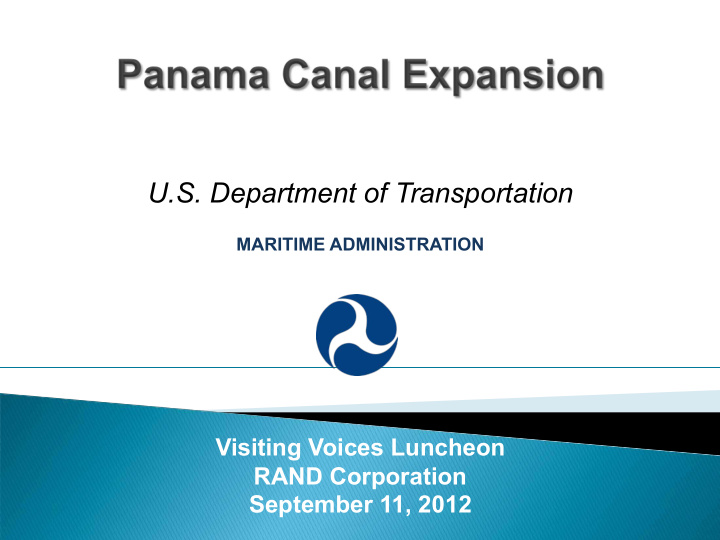



U.S. Department of Transportation MARITIME ADMINISTRATION Visiting Voices Luncheon RAND Corporation September 11, 2012
Purpose Evaluate and assess anticipated economic and infrastructure • impacts on U.S. ports and freight transportation infrastructure. Objectives • Provide a foundation for a realistic understanding of the impacts of Canal expansion on U.S. ports and the national transportation system. • Identify the range of needs for both private/public investment. • Recommend pragmatic policy options for the Federal government to maximize investment value. • Identify Port and infrastructure policy opportunities for consideration by Federal government leadership.
Phase I (Commenced Late 2010 – Completed August 2012) General Listening Sessions Phase I Peer Review Phase I Report & Methodology Release Phase I Report to the public Phase II/III (Will Commence Late Fall 2012) Phases One-on-One Interviews with U.S. Maritime Communities On-Line Survey of 5,000 Shippers II/III Peer Review of Remaining Phases Listening Session in Washington, DC Phase IV (November 2012 – January 2013) Develop Policy and Investment Recommendations Phase IV Produce draft final report Release the approved report to the public
• Listening Sessions • San Francisco, CA (September 2011) • New York, NY (September 2011) • Washington, DC (Early 2013) • Stakeholder Engagement • Shipper Survey to 5000 International Shippers and Service Providers • One-on-One Stakeholder Interviews with Port Officials • Federal Agency Engagement • DOT Chain Gang • USACE • USCG • Formal Peer Review Process • Transportation Research Board
U.S. DOT Army Corps Technical Panama Canal U.S. Port and Inland Coordination Expansion Study (PCES) Waterways Modernization Study Institute for Water Resources • PCES will provide a (IWR) Centers of Expertise • The purpose of the comprehensive examination of Deep Draft Center of Modernization Study is to how the Panama Canal • Expertise expansion will affect the entire address the critical need for Inland Center of Expertise transportation system (U.S. additional port and inland • ports, waterways, rail and other waterway modernization to landside infrastructure). US Army Corps of Engineers accommodate post-Panamax Special Teams: vessels. • PCES will involve a robust Environmental Team • The US Port and Inland • outreach effort – stakeholder Dredging/Costing Team Waterways Modernization • interviews, listening sessions and Aquatic Invasive Species Strategy will develop a vision • outreach initiatives designed to Team for meeting the needs for US assist MARAD in prioritizing Port Capacity Team future investments in the U.S. port and inland waterway • Public Communications Team port infrastructure system. modernization and propose a • high-level strategy to implement that vision.
• One-on-one interviews with key stakeholders (i.e. ports, railroads and shippers) • Verification of markets and costs through shipper surveys • Assessment of operational responses to expansion-driven scenarios • Continue listening sessions, peer reviews and other public outreach program initiatives • Coordinate with other on-going studies
} Establishes a National Freight Policy focused on improving the condition and performance of the freight network to provide foundation for the U.S. to compete in the global economy (Sec. 1115) } Requires DOT to: ◦ establish a national freight network ◦ Create a national freight strategic plan ◦ Create a freight conditions and performance report ◦ Create new or refine existing transportation investment and data planning tools to evaluate freight-related and non-freight related projects ◦ Encourage States to create freight plans and state freight advisory committees DOT has created the Freight Policy Council in order to coordinate cross- modal implementation of MAP-21
Recommend
More recommend